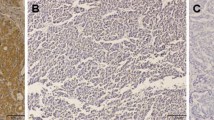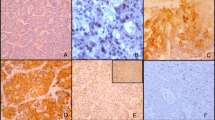Abstract
Aim
To examine the expressions of focal adhesion kinase (FAK) and its clinical significance in hepatocellular carcinoma (HCC).
Methods
We determined the expression levels of FAK on both steady-state mRNA and protein levels in 50 HCC samples by quantitative real-time PCR and immunohistochemistry, respectively. The correlations between FAK expression and various clinicopathological parameters were analyzed.
Results
The expression of FAK on the mRNA level was consistent with that on the protein level. FAK mRNA levels in tumor tissues were significantly higher than in the paratumor tissues (0.229 ± 0.027 vs. 0.163 ± 0.019; P < 0.001), but lower than in the macroscopic cancer emboli (0.506 ± 0.155 vs. 0.377 ± 0.176; P < 0.05). Compared within the tumor tissues, FAK expressions were significantly higher in those with cancer emboli than those without (0.343 ± 0.05 vs. 0.165 ± 0.025; P = 0.003). Univariate and multivariate analyses revealed that FAK expression was an independent prognostic factor for disease-free survival and overall survival. Both 3-year disease-free survival rates and overall survival rates in FAK-negative group were significantly higher than in positive group (52 vs. 20% and 72 vs. 29%, P < 0.001).
Conclusion
Our results suggest that FAK expression is up-regulated in HCC and its expression is an independent prognostic factor for HCC.




Similar content being viewed by others
References
Bosch FX, Ribes J, Diaz M, Cleries R (2004) Primary liver cancer: worldwide incidence and trends. Gastroenterology 127:5–16
Cance WG, Harris JE, Iacocca MV, Roche E, Yang X, Chang J, Simkins S, Xu L (2000) Immunohistochemical analyses of focal adhesion kinase expression in benign and malignant human breast and colon tissues: correlation with preinvasive and invasive phenotypes. Clin Cancer Res 6:2417–2423
Fujii T, Koshikawa K, Nomoto S, Okochi O, Kaneko T, Inoue S, Yatabe Y, Takeda S, Nakao A (2004) Focal adhesion kinase is overexpressed in hepatocellular carcinoma and can be served as an independent prognostic factor. J Hepatol 41:104–111
Greene FL, Page DL, Fleming ID (2002) AJCC cancer staging manual, 6th edn. Springer, New York, pp 131–144
Han NM, Fleming RY, Curley SA, Gallick GE (1997) Overexpression of focal adhesion kinase (p125FAK) in human colorectal carcinoma liver metastases: independence from c-src or c-yes activation. Ann Surg Oncol 4:264–268
Itoh S, Maeda T, Shimada M, Aishima S, Shirabe K, Tanaka S, Maehara Y (2004) Role of expression of focal adhesion kinase in progression of hepatocellular carcinoma. Clin Cancer Res 10:2812–2817
Mol AJ, Geldof AA, Meijer GA, van der Poel HG, van Moorselaar RJ (2007) New experimental markers for early detection of high-risk prostate cancer: role of cell–cell adhesion and cell migration. J Cancer Res Clin Oncol 133:687–695
Owens LV, Xu L, Craven RJ, Dent GA, Weiner TM, Kornberg L, Liu ET, Cance WG (1995) Overexpression of the focal adhesion kinase (p125FAK) in invasive human tumors. Cancer Res 55:2752–2755
Owens LV, Xu L, Dent GA, Yang X, Sturge GC, Craven RJ, Cance WG (1996) Focal adhesion kinase as a marker of invasive potential in differentiated human thyroid cancer. Ann Surg Oncol 3:100–105
Parikh S, Hyman D (2007) Hepatocellular cancer: a guide for the internist. Am J Med 120:194–202
Schlaepfer DD, Mitra SK, Ilic D (2004) Control of motile and invasive cell phenotypes by focal adhesion kinase. Biochim Biophys Acta 1692:77–102
Sood AK, Coffin JE, Schneider GB, Fletcher MS, DeYoung BR, Gruman LM, Gershenson DM, Schaller MD, Hendrix MJC (2004) Biological significance of focal adhesion kinase in ovarian cancer: role in migration and invasion. Am J Pathol 165:1087–1095
Theocharis SE, Kouraklis GP, Kakisis JD, Kanelli HG, Apostolakou FE, Karatzas GM (2003) Focal adhesion kinase expression is not a prognostic predictor in colon adenocarcinoma patients. Eur J Surg Oncol 29:571–574
Too HP (2003) Real time PCR quantification of GFRalpha-2 alternatively spliced isoforms in murine brain and peripheral tissues. Brain Res Mol Brain Res 114:146–153
Tremblay L, Hauck W, Aprikian AG, Begin LR, Chapdelaine A, Chevalier S (1996) Focal adhesion kinase (pp125FAK) expression, activation and association with paxillin and p50CSK in human metastatic prostate carcinoma. Int J Cancer 68:164–171
Wu H, Liang YL, Li Z, Jin Zhang W, Duan L, Zha X (2006) Positive expression of E-cadherin suppresses cell adhesion to fibronectin via reduction of alpha5beta1 integrin in human breast carcinoma cells. J Cancer Res Clin Oncol 132:795–803
Acknowledgments
This study was supported by the National Natural Science Foundation of China, No.30872512.
Author information
Authors and Affiliations
Corresponding author
Rights and permissions
About this article
Cite this article
Yuan, Z., Zheng, Q., Fan, J. et al. Expression and prognostic significance of focal adhesion kinase in hepatocellular carcinoma. J Cancer Res Clin Oncol 136, 1489–1496 (2010). https://doi.org/10.1007/s00432-010-0806-y
Received:
Accepted:
Published:
Issue Date:
DOI: https://doi.org/10.1007/s00432-010-0806-y




